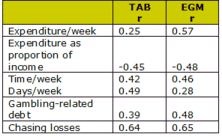Scientific research on gambling has focused on how the cognitive processes of pathological gamblers differ from those of “healthy” subjects (e.g., Cavedini, Riboldi, Keller, D’Annucci, & Bellodi, 2002; Ladouceur & Walker, 1998; Sylvain, Ladouceur, & Boisvert, 1997). Central to this debate is whether pathological gamblers experience a disruption of the ability to recognize and regulate time and money spent. Similarly, a recent study by O’Connor and Dickerson (2003) analyzed gamblers’ self-reported impaired control to see if behavioral differences exist between two different categories of gamblers (i.e., off-track and electronic gaming machine gamblers) and if gambling involvement was associated with self-perceived impaired control. This week’s WAGER presents the results of their study.
O’Connor and Dickerson recruited a convenience sample of 84 male off-track Totalizator Agency Board (TAB)* horse/dog gamblers, and 137 (64 male) electronic gaming machine (EGM) gamblers at various gaming sites in Adelaide, South Australia. The authors studied TAB and EGM groups because they are venue-specific and represent distinctly different forms of gambling. They recruited participants between the hours of 10:00 am and 4:00 pm and required all subjects to be at least 18 years of age and have reported gambling at a TAB or EGM venue (depending on group) at least once per week during the past six months. Subjects were administered a questionnaire developed by O’Connor for a previous study (1995): this instrument collected information on subjects’ demographics, gambling behaviors, and impulse behaviors [using a modified version of the Scale of Gambling Choices*** (Baron, Dickerson, & Blaszczynski, 1995)]. The questionnaire contained twelve questions using a scale ranging from 0 to 4 to measure impaired control during the past six months; larger numbers indicated more frequent impaired control, with a total of 48 possible points. The authors analyzed the scores after transforming the data to logarithms to minimize the effect of outliers (e.g., average weekly gambling expenditures varied greatly).
Table 1. Correlations Between Gambling Involvement Variables and Impaired Control Scores (O’Connor & Dickerson, 2003)**
** all coefficients shown are significant at p<0.01
The authors noted a statistically significant difference between the responses of TAB and EGM gamblers within several impaired control categories (e.g., “not able to stop before all cash spent,” .2=5.23, p<0.05; “not able to gamble less often,” .2=5.63, p<0.05). The overall raw scores for impaired control between TAB and EGM gamblers, however, did not differ significantly (M=10.02, SD=9.21; vs. M=12.12, SD=10.42 respectively). All of the gambling involvement variables (e.g., time spent gambling each week) were significantly correlated with impaired control scores across both groups (see Table 1), suggesting that gamblers who report experiencing more frequent impulsive behaviors may be more likely to report maladaptive gambling behaviors. One notable exception however, was that impaired control was negatively correlated with expenditure as a proportion of income, suggesting increased spending discretion at higher levels of impaired control.
This study had a number of methodological limitations, several of which the authors noted. First, employing a convenience sampling strategy during daytime hours might not have yielded a representative cross-section of regular gamblers, especially since the authors reported that only one-third of those approached agreed to participate. Other sources of potential bias include the fact that the sample of TAB gamblers did not include any female subjects, and that the instruments relied on self-report to collect all data. Finally, the authors did not use DSM-IV, SOGS, or any other criteria to screen participants for pathological gambling; thus, there is no information about the true presence or absence of disordered gambling within the study sample.
Nonetheless, the data indicated that impaired control correlated significantly with behaviors (e.g., gambling frequently, chasing losses) that are frequently associated with disordered gambling. O’Connor and Dickerson suggest that further study of the connection between impaired control and excessive behaviors, including disordered gambling, may ultimately contribute to the overall understanding of the motivating factors associated with gambling addiction. Although they also suggest that impaired control may be an overarching characteristic of addiction in general (and therefore might constitute a link between pathological gambling and other types of addiction), without further investigation it is likely too soon to make this definitive connection. While this article provides preliminary support to the hypothesis that disordered gambling—regardless of game type or demographics—may be associated with impulsive behaviors, further comparison among distinct segments of the gambling population will likely clarify this relationship.
Comments on this article can be addressed to Tony Donato.
Notes
* The South Australian Totalizator Agency Board (TAB) is a proprietary company empowered by the Australian Racing Act of 1976 to conduct off-course betting on thoroughbred, harness, and greyhound racing within and outside Australia. Totalizator wagering is also known as pari-mutuel wagering.
*** The modified version of the Scale of Gambling Choices contained 12 items designed to collect information on session initiation cues, session termination behaviors, and factors influencing subjects’ resistance to urges to gamble.
References
Baron, E., Dickerson, M., & Blaszczynski, A. (1995). ‘The Scale of Gambling Choices’: preliminary development of an instrument to measure impaired control of gambling behaviour. In J. O’Connor (Ed.), High stakes in the nineties (2nd ed.). Melbourne: National Association for Gambling Studies.
Cavedini, P., Riboldi, G., Keller, R., D’Annucci, A., & Bellodi, L. (2002). Frontal lobe dysfunction in pathological gambling patients. Biological Psychiatry, 51, 334-341.
Ladouceur, R., & Walker, M. (1998). The cognitive approach to understanding and treating pathological gambling. In A. S. Bellack & M. Hersen (Eds.), Comprehensive Clinical Psychology. New York: Pergamon.
O’Connor, J., & Dickerson, M. (2003). Impaired control over gambling in gaming machine and off-course gamblers. Addiction, 98, 53-60.
O’Connor, J., Dickerson, M., & Phillips, M. (1995).
Chasing and its relationship to impaired control over gambling. In J. O’Connor (Ed.), High stakes in the nineties (2nd ed.). Melbourne: National Association for Gambling Studies.
Sylvain, C., Ladouceur, R., & Boisvert, J. M. (1997). Cognitive and behavioral treatment of pathological gambling: A controlled study. Journal of Consulting & Clinical Psychology, 65(5), 727-732.





